Hidden Music in Geneva
By John Marks, Curator of Collections & Exhibits
Music is everywhere in Geneva for those with eyes to see. The digital marquee on Seneca Street, event flyers in many downtown store windows, and websites like www.thesmith.org.

Undated program, probably late 1800s.
More intriguing to me is the music we don’t see. For most Genevans I am an example of this. I play multiple instruments (and own several more that I might learn to play someday) but usually at home or with a few friends. When I do play in public, I always hear, “I didn’t know you play [instrument d’jour]!”
Why would people know? In the 21st century live music is optional. Music is available on phones and watches, auto-tuned and polished to a fare-thee-well. Like sugar, it once was hard to come by but now it’s in everything. We’ve forgotten that scarcity used to make it a treat. Like baking, some people enjoy the making as much or more than the consumption.
In the 1700s and 1800s, if you wanted music you had to play it or know someone who did. That person needed an instrument and aptitude, either for playing by ear or for reading music. If the latter, then sheet music was also needed. Then as now, there were all kinds of music for all occasions. A sea chantey or tavern song might not be very hard; music to impress a suitor was more difficult.
 The music to the left is from the songbook of Eliza Leet, 1800 (and passed down to two generations), now in possession of Trinity Episcopal Church. Everything was hand-written which was no small task. I haven’t asked pianists to give this song a try yet, but I’m sure it takes more than five minutes of practice.
The music to the left is from the songbook of Eliza Leet, 1800 (and passed down to two generations), now in possession of Trinity Episcopal Church. Everything was hand-written which was no small task. I haven’t asked pianists to give this song a try yet, but I’m sure it takes more than five minutes of practice.
Many of these songs and pieces were played in the home for family and close friends. Public performances by local musicians weren’t much larger. Mid-19th-century halls, like the Linden and Dove Blocks, brought in professional musicians. This supplemented, rather than silenced, the work of home musicians.
The Tuesday Piano Quartette traces its roots back to this kind of music. A piano quartet might be a piano and three stringed instruments, or four pianos. This quartette (their preferred spelling) is four people at two pianos, or eight-hand music. Most of the music was published in Europe where it was more popular. Very few composers wrote, or write, music for eight-hand piano, and only slightly more musicians write arrangements for it.

Tuesday Piano Quartette, early 1950s.
The current group marks its beginning as 1922 but eight-hand music was played in Geneva several decades earlier. The group (always women, with a few occasional males invited to sit in) met each Tuesday for several hours. During the early 1940s they performed publicly at the Woman’s Club and in churches. They also gave invitation-only recitals at the home of Mrs. Sidney Smith on Castle Street.
From the 1970s to the 2000s, the Quartette performed publicly about once every five years. A special challenge is finding and tuning two piano, as well as the usual event-planning issues. Even with no performances in sight – many non-musicians might assume that a performance is the whole reason for playing – the Quartette meets every Tuesday afternoon. Tea and cookies are served at the halfway point as it has been for 96 years.

Letter to the Tuesday Piano Quartette from George MacNabb, University of Rochester piano professor and coach to the Quartette.
A full-length article about the Quartette will appear later this year, but for now I will close with two quotes.
“This quartette owes its great fame to the fact that it has produced less good music and more good times and conversation than any other similar body of musicians ever gathered together in one accord.” – Introduction to the first Tuesday Piano Quartette scrapbook
“You make and experience the music yourselves, and over all the years—in this mechanized age. After all, the real thrill of music is the experiencing in the making of it.” – George MacNabb, University of Rochester piano professor and coach to the Quartette
